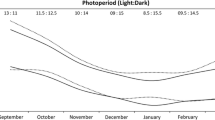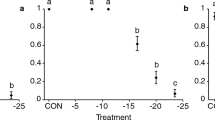Abstract
Lysiphlebus testaceipes (Cresson) (Hymenoptera: Braconidae, Aphidiinae) is a parasitic wasp which plays an important role in the biological control of a number of aphid species. Through assessment of its thermal biology and low temperature tolerance, this study ascertains the establishment potential of L. testaceipes in cool temperate climates typical of northern Europe. The developmental threshold of L. testaceipes was 5.8°C. Rearing of parasitoids at shorter day lengths and lower temperatures indicated no ability to enter a diapause state. The supercooling points (SCP) of non-acclimated and acclimated parasitoid life stages were between −24.6°C and −17.7°C, with LTemp50 temperatures approaching these values, indicating a high level of cold tolerance in short exposures. At 5°C the LTime50 of acclimated larvae within parasitized aphids was 42.8 days. Acclimated pupae continued to develop with 54% adult emergence from mummies within 60 days. Acclimated parasitoid larvae and pupae, within living and mummified aphids, continued to develop during 70 days of winter field exposure and emerging adult parasitoids were reproductively viable under field conditions. These data indicate that where suitable host species are available throughout the year, L. testaceipes would be able to establish in northern Europe.









Similar content being viewed by others
References
Allen CM (2010) Thermal biology and behaviour of two predatory Phytoseiid mites: Amblyseius swirskii (Athias-Henriot) (Acari: Phytoseiidae) and Phytoseiulus longipies (Evans) (Acari: Phytoseiidae). School of Biosciences. Birmingham, The University of Birmingham. Doctor of Philosophy 206
Austin ABM, Tatchell GM, Harrington R, Bale JS (1991) A method for rearing cereal aphids in a small space. Entomol Exp Appl 61:91–93
Bale JS, O’doherty R, Atkinson HJ, Stevenson RA (1984) An automatic thermoelectric cooling method and computer-based recording-system for supercooling point studies on small invertebrates. Cryobiology 21:340–347
Blackman RL (1971) Variation in the photoperiodic response within natural populations of Myzus persicae (Sulzer). B Entomol Res 60:533–546
Draper N, Smith H (1981) Applied regression-analysis. John Wiley and Sons, New York
Finney DJ (1971) Probit analysis. Cambridge University Press, Cambridge
Hart AJ, Bale JS, Tullett AG, Worland MR, Walters KFA (2002a) Effects of temperature on the establishment potential of the predatory mite Amblyseius californicus McGregor (Acari: Phytoseiidae) in the UK. J Insect Physiol 48:593–599
Hart AJ, Tullett AG, Bale JS, Walters KFA (2002b) Effects of temperature on the establishment potential in the U.K. of the non-native glasshouse biological control agent Macrolophus caliginosus. Physiol Entomol 27:112–123
Hatherly IS, Bale JS, Walters KFA, Worland MR (2003) Thermal biology of Typhlodromips montdorensis: implications for its introduction as a glasshouse biological control agent in the UK. Neth Entomol Soc 111:97–109
Hatherly IS, Bale JS, Walters KFA, Worland NR (2004) Thermal biology of Typhlodromips montdorensis: implications for its introduction as a glasshouse biological control agent in the UK. Entomol Exp Appl 111:97–109
Hatherly IS, Hart AJ, Tullett AG, Bale JS (2005) Use of thermal data as a screen for the establishment potential of non-native biological control agents in the UK. BioControl 50:687–698
Hatherly IS, Pedersen BP, Bale JS (2008) Establishment potential of the predatory mirid Dicyphus hesperus in northern Europe. BioControl 53:589–601
Hokkanen H (2003) Biological control agents: safety and regulatory policy. BioControl 48:477–484
Hughes GE, Bale JS, Sterk G (2009) Thermal biology and establishment potential in temperate climates of the predatory mirid Nesidiocoris tenuis. BioControl 54:785–795
Jackson HB, Coles LW, Wood EA, Eikenbar RD (1970) Parasites reared from greenbug and corn leaf in Oklahoma in 1968 and 1969. J Econ Entomol 63:733–736
Jones DB, Giles KL, Elliott NC, Payton ME (2007) Parasitism of greenbug, Schizaphis graminum, by the parasitoid Lysiphlebus testaceipes at winter temperatures. Environ Entomol 36:1–8
Jones DB, Giles KL, Elliot NC (2008) Supercooling points of Lysiphlebus testaceipes and its host Schizaphis graminum. Environ Entomol 37:1062–1068
Li WX, Li JC, Coudron TA, Lu ZY, Pan WL, Liu XX, Zhang QW (2008) Role of photoperiod and temperature in diapause induction of endoparasitoid wasp Microplitis mediator (Hymenoptera: Braconidae). Ann Entomol Soc Am 101:613–618
Mackauer M, Starý P (eds) (1967) Ichneumonoidae, World Aphidiidae. Index of Entomophagous Insects, Le François Paris
Mehrnejad MR, Copland MJW (2005) Diapause strategy in the parasitoid Psyllaephagus pistaciae. Entomol Exp Appl 116:109–114
Olsen A, Bale JS, Leadbeater BSC, Callow ME, Holden JB (2003) Developmental thresholds and day-degree requirements of Paratanytarsus grimmii and Corynoneura scutellata (Diptera: Chironomidae): two midges associated with potable water treatment. Physiol Entomol 28:315–322
Rodrigues SMM, Bueno VHP (2001) Parasitism rates of Lysiphlebus testaceipes (Cresson) (Hym.: Aphidiidae) on Schizaphis graminum (Rond.) and Aphis gossypii Glover (Hem.: Aphididae). Neotrop Entomol 30:625–629
Ruxton GD (2006) The unequal variance t-test is an underused alternative to Student’s t-test and the Mann–Whitney U test. Behav Ecol 17:688–690
Shufran KA, Weathersbee AA III, Jones DB, Elliott NC (2004) Genetic similarities among geographic isolates of Lysiphlebus testaceipes (Hymenoptera: Aphidiidae) differing in cold temperature tolerances. Environ Entomol 33:776–778
Silva RJ, Bueno VHP, Sampaio MV (2008) Quality of different aphids as hosts of the parasitoid Lysiphlebus testaceipes (Cresson) (Hymenoptera: Braconidae, Aphidiinae). Neotrop Entomol 37:173–179
Starý P, Lyon JP, Leclant F (1988a) Post-colonization host range of Lysiphlebus testaceipes in the mediterranean area (Hymenoptera aphidiidae). Acta Entomol Bohemos 85:1–11
Starý P, Lyon JP, Leclant F (1988b) Biocontrol of aphids by the introduced Lysiphlebus testaceipes (Cress.) (Hym., Aphidiidae) in Mediterranean France. J Appl Entomol 105:74–87
Starý P, Lumbierres B, Pons X (2004) Opportunistic changes in the host range of Lysiphlebus testaceipes (Cr.), an exotic aphid parasitoid expanding in the Iberian Peninsula. J Pest Sci 77:139–144
Tremblay E (1984) The parasitoid complex [Hym.: Ichneumonoidea] of Toxoptera aurantii [Hom.: Aphidoidea] in the Mediterranean area. Entomophaga 29:203–209
Tullett AG (2002) Methodologies for assessing the effects of low temperature on the establishment potential of non-native arthropods. School of Biosciences. Birmingham, The University of Birmingham. Doctor of Philosophy 130
Tullett AG, Hart AJ, Worland MR, Bale JS (2004) Assessing the effects of low temperature on the establishment potential in Britain of the non-native biological control agent Eretmocerus eremicus. Physiol Entomol 29:363–371
van Lenteren JC, Bigler F, Burgio G, Hokkanen HMT, Thomas MB (2002) Risks of importation and release of exotic biological control agents: how to determine host specificity. Bulletin IOBC/WPRS 25:281–284
van Lenteren J, Bale J, Bigler F, Hokkanen HMT, Loomans AJM (2006) Assessing risks of releasing exotic biological control agents of arthropod pests. Annu Rev Entomol 51:609–634
Acknowledgments
Gwennan E. Hughes was funded by the Biotechnology and Biological Sciences Research Council (BBSRC) in a CASE studentship with Biobest.
Author information
Authors and Affiliations
Corresponding author
Additional information
Handling Editor: Torsten Meiners.
Rights and permissions
About this article
Cite this article
Hughes, G.E., Sterk, G. & Bale, J.S. Thermal biology and establishment potential in temperate climates of the aphid parasitoid, Lysiphlebus testaceipes . BioControl 56, 19–33 (2011). https://doi.org/10.1007/s10526-010-9314-x
Received:
Accepted:
Published:
Issue Date:
DOI: https://doi.org/10.1007/s10526-010-9314-x




